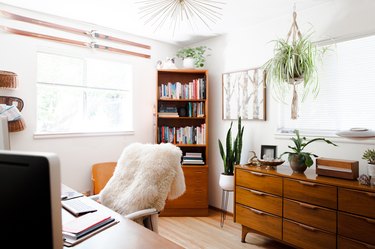A musty smell clinging to wood furniture often means the piece came from a room with excessive moisture and not enough sunlight to dry things out properly. That odor is often an indicator of mildew too, so there's a good chance the wood needs a thorough cleaning. Get rid of that musty odor by setting the piece outside during dry conditions and cleaning it up a bit to remove any potential mildew. Vinegar is also a natural odor-removing substance that comes in handy for removing any scents that seem trapped within wood.
Wondering how to refresh musty-smelling wooden furniture? Here's what to do.
Video of the Day
Video of the Day
Take Musty Furniture Outside
Take that offensive odor-containing furniture outside on a dry, moderately warm day, setting it in a place where it's safe to remain for much of the day. Open any doors or drawers; take the drawers out fully if they seem easy to remove and replace.
If possible, set the piece in an area with filtered or partial sunlight, as the warmth of the sun helps remove any moisture trapped within the piece. Full sunlight is nice for a little while but avoid leaving the furniture in full sun for hours on end if you're concerned the heat might affect the finish or other elements of the wood furniture. A thorough cleaning with a vacuum cleaner that has a HEPA filter is a great way to remove dust and dirt. Then, follow up on all surfaces with a lint-free dust cloth.
If you don't have a good place to set the piece in the yard or driveway, a porch works well, as does a garage with the main door open. When such spaces aren't an option, set the piece in a room where you can open the windows to allow in fresh air and daylight, ideally in an area of the home where you won't spend much time during the airing-out process. Depending on the severity of the musty odor, it may take several days to air out the piece outside (bringing it in at night) or potentially longer indoors.
Try an Odor-Absorbing Wipe-Down
Diluted vinegar is gentle enough to remove the remaining dirt, grime, and odors from all sorts of household surfaces, but it's still best to test it on an inconspicuous area of the wood to ensure it won't harm the finish.
- Mix equal parts white vinegar and warm water in a spray bottle and then add a squirt of a gentle dish soap.
- Spritz one wood surface at a time with a light mist of the vinegar solution and then wipe it off with a dry, lint-free cloth, such as microfiber or cotton.
- Spray and clean every part of the wood furniture, including the legs, underside, and inside the drawers to remove any hidden mildew as well as trapped odors.
Ideally, do the cleaning outdoors or in a well-ventilated, dry area to ensure the wood doesn't stay damp for long.
Tip
When you clean anything that smells musty, it's a good idea to wear a dust mask to avoid breathing in potential allergens.
Deal With Mold
Small spots remaining on the wood furniture even after a vinegar wipe-down might be mold or mildew, but in most cases, those spots come off fairly easily. With the furniture outdoors, spray more of the vinegar solution on the spots and scrub them with a nylon-bristle scrub brush or mix 1 cup borax with a gallon of water. Spray the furniture with the borax solution. Use the scrub brush to remove the spots and then leave the borax solution in place for several hours before wiping it off with a damp cloth. Borax creates an alkaline environment that helps prevent mold growth. Don't use vinegar and borax together, as vinegar cancels out the alkaline properties of borax.
If the wood doesn't have a sealant on it, create a borax mixture to soak into the wood by boiling 1/2 cup borax in 2 quarts water until the mixture thickens a little. When it cools slightly, brush the solution over the wood with a paintbrush and let it dry in place. This is a good option for any furniture you plan to paint over using a stain-blocking primer and mold-resistant paint. If you're concerned about how the borax solution might affect the wood, test it on an inconspicuous area and let it dry before using it on the entire piece.
